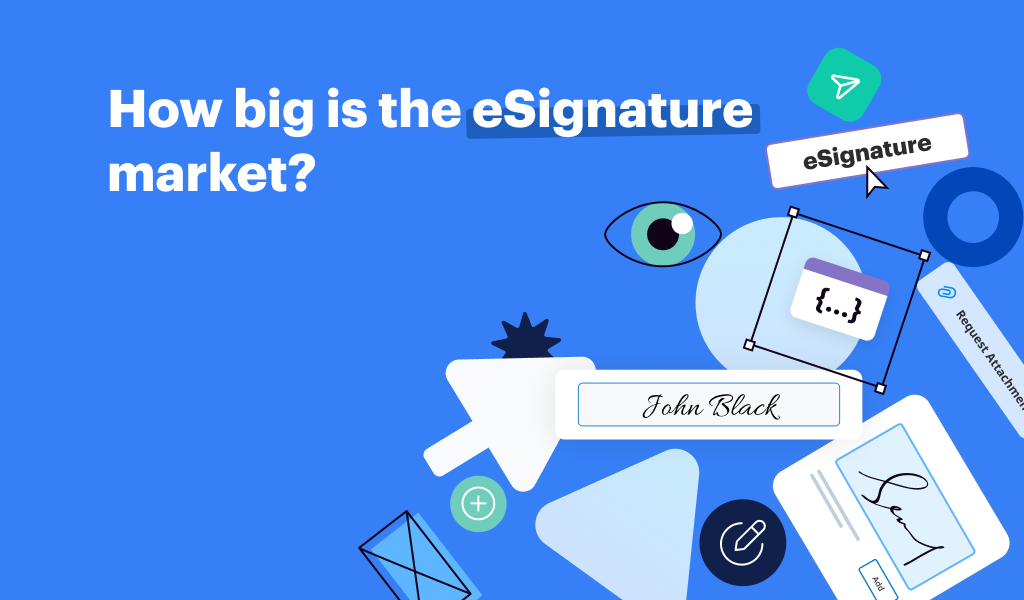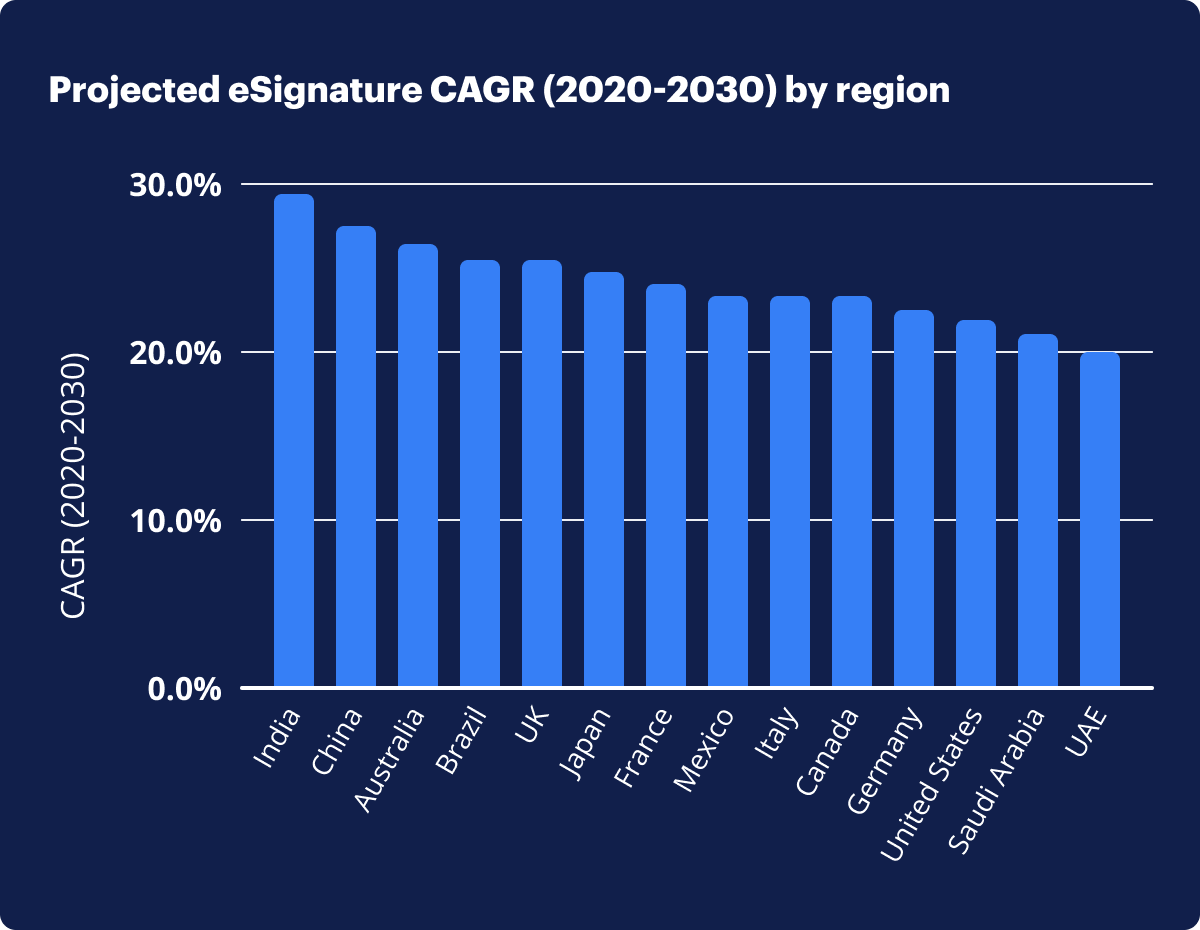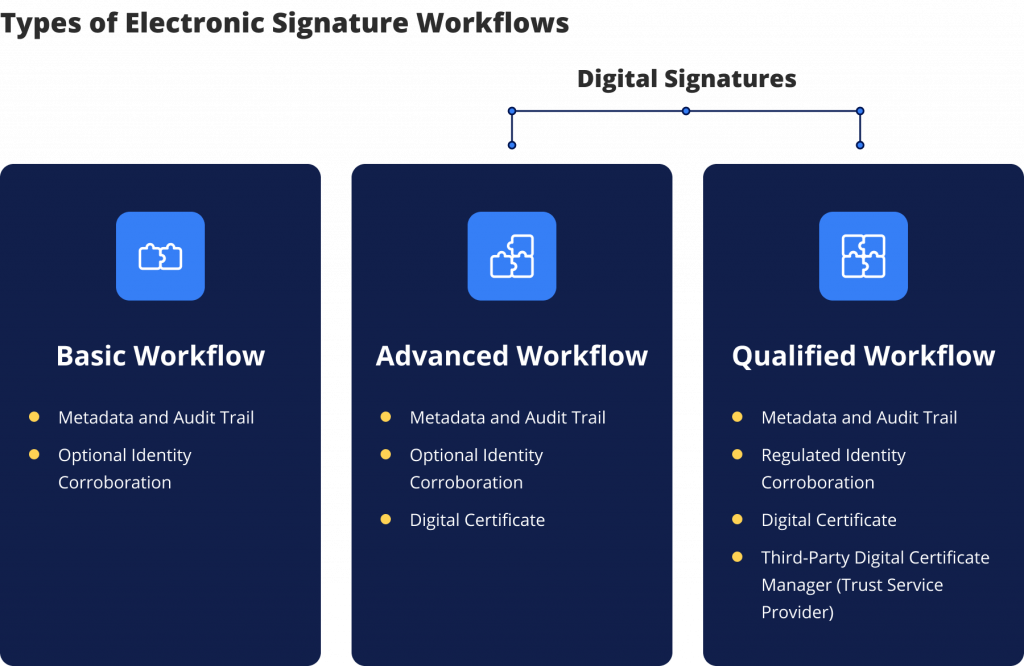
As 2022 continues on, eSignature is becoming the new norm in our post-COVID-19 reality. Given the circumstances, knowing how big the eSignature market has become can help businesses choose eSignature solutions to fit their needs, and providers – to stay ahead of the demand. A recent airSlate survey showed that the use of eSignature across US businesses and households dramatically increased during the pandemic. According to our data, the number of business users increased by 50%, while individual users made up 13% of adopters.
In this blog, we’ll walk you through the state of the eSignature market to date, while also exploring the global market opportunity. We’ll look into why eSignature technology has become a business necessity along with workflow automation solutions and why more companies need to focus on adopting these technologies in the near future.
eSignature market growth statistics
Despite the ever-growing demand for eSignature in a vast selection of use cases, the eSignature market remains fairly underpenetrated. According to numerous studies, there’s a substantial untapped market for electronic signature vendors to explore. With DocuSign as the major market player commanding the lion’s share of around 70%, eSignature companies like signNow and other DocuSign competitors have plenty of opportunities to penetrate foreign markets.
The increase in demand for workflow automation solutions and SaaS deployment has resulted in the fast-paced adoption of eSignature across different industries. Not to mention the growing number of eSignature integrations with third-party business apps. This is why more and more SMBs and enterprises have made leveraging these fundamental digital transformation solutions a top priority.
According to SeekingAlpha, the growth of the eSignature market stands at 20% annually and currently sits at $25 billion. Given the low market segment penetration and relatively few players, the top three to four vendors have a substantial opportunity to grow without diminishing one another.
A recent Prescient & Strategic Intelligence data from June 2021 suggests that the global eSignature market will reach $12,721.4 million at a CAGR of 26.6% from 2021–2030. Geographically, the United States currently holds the largest share of approximately 22% with the Asia-Pacific (APAC) eSignature market close behind. APAC is expected to exhibit the fastest growth during the forecasted period due to its rapid digitalization. Additionally, India, China, and Brazil are expected to register the highest CAGR during the forecasted period.

source: P&S Intelligence E-Signature Market Research Report
How big is the eSignature market?
In this chapter, we won’t be reducing all of the available eSignature apps to just DocuSign competitors, nor will we claim that a certain app is the best e signature solution for business. Instead, we’ll focus on the specifics of market offerings that are helpful to SMBs and enterprises across the globe.
In fact, the pandemic helped businesses figure out the capacity requirements for eSignature apps as well as broaden the scope of eSignature use cases. Some businesses misjudged the capacity requirements for eSignature, and as a result, are having to renew their volumes after having exhausted them. Others managed to introduce eSignature to new areas such as insurance, public schools, small business loans, and employee onboarding.
As soon as eSignature was made a part of enterprise apps, many organizations worked to integrate it into multiple business processes. It’s clear that eSignature technology will continue to be the major revenue driver for organizations in the years to come. So, what are the current options businesses have?
3 common types of eSignature
According to Gartner, three common types of eSignature are used worldwide:
- Basic (click-to-sign) eSignature (BES) that doesn’t use digital certificates is widely used in the United States, Australia, Canada, Ireland, New Zealand, and the U.K. because these countries have technology-neutral legal frameworks. Basic eSignatures are easy to implement, while also having a low impact on the user experience.
- Advanced eSignature (AES) uses a self-acquired digital certificate attributed to each signer to protect a document from tampering or alterations after it has been signed.
- Qualified eSignature (QES) is mostly used in the EU, Asia Pacific, the Middle East, and South America since their legislation is more prescriptive with regards to eSignature technology. Using a QES requires a digital certificate attributed to an individual based on a digital ID validated by a government- or industry-sponsored identity proofing scheme.

Modern eSignature offerings are distinguished by type:
- public key infrastructure (PKI) solutions
- username and PIN
- signature pad at point of sale (POS)
- clickwrap
- voice signature, and others.
In 2020, the PKI eSignature solutions category was one of the fastest to grow. The PKI eSignature allows for ensuring signer and document authenticity via a combination of standards, policies, hardware, and software as trusted entities for eSignature validation. This is why more and more organizations are leveraging these solutions for cybersecurity management.
Based on components, eSignature solutions are split into software, hardware, and service. The lack of technical skills required to manage large-scale operations has resulted in an increasing need for cloud, consultancy, maintenance, and implementation services. Research indicates that the managed services category accounted for a larger portion of the eSignature market in 2020 due to the growing demand for higher security and cost savings among enterprises. P&S Intelligence predicts that eSignature as a service will experience the fastest growth throughout 2021-2030.
Today, eSignature vendors offer a range of services in addition to standard eSigning functionality – custom workflows, eSigning on mobile, multi-factor authorization, ID verification, third-party integrations with productivity and business apps, APIs and SDKs. For instance, signNow and other business-process-centered solutions offer app integrations via a system of record that is capable of automatically populating specific document fields and exporting data back into them.
How to choose an eSignature solution for business?
In one of our recent posts, we covered the top 20 DocuSign alternatives in 2022. In this chapter, we’ll briefly focus on the business requirements for eSignature solutions.
The ROI of eSignature
Leveraging eSignature helps SMBs and enterprises eliminate physical paperwork and improve internal compliance in business processes across different industries. The ROI delivered by eSignature solutions can be assessed through accelerated document turnaround, savings in postage, delivery and administrative fees, the minimization of physical storage, and environmental impacts.
Enabling eSignature technology allows for reducing the timespan for customer acquisition. Overall, this results in improved customer onboarding and transaction completion processes. This reduces churn as well as the rate of canceled business transactions due to delays or other hassles such as manually filling out (prone to error) and returning paper forms.
Identifying business requirements for eSignature
Use cases
Prior to purchasing an eSignature solution, many SMBs and enterprises fail to identify every foreseeable requirement, often resulting in failed expectations. It’s wise to start by categorizing the eSignature use cases that are generally split into the following three groups:
- Business to business (B2B) i.e. NDAs, procurement, CPQ, and sales and service agreements.
- Business to сonsumer (B2C) i.e. managing documents required for client accounts, forms and applications, sales, and service terms.
- Business to employee (B2E) i.e. employee onboarding, employment contracts, benefits paperwork, etc.
Once the scope of eSignature use cases has been identified, a business needs to look into the jurisdictional requirements for each of them. The goal here is to exclude any use case that existing resources and apps can manage.
Deployment requirements
Business-process-focused eSignature vendors offer a SaaS delivery model, but only a few providers, including signNow (airSlate), offer a private cloud or on-premises deployment model. Most businesses gravitate towards a SaaS-based eSignature as part of their workflow automation solution, and here’s why:
| Flexible deployment — Whether deployed on a public or private cloud, these solutions represent a ready-made platform provisioned by the vendor. It’s easy to select different deployment options to meet specific business needs without engaging an IT department. | |
|
Support and maintenance — SaaS-based eSignature has minimal IT dependency on app maintenance since the vendor is responsible for infrastructure risks to ensure prompt disaster recovery. | |
|
Upgrade cycles — Upgrade schedules are fully controlled and leveraged by the vendor, which can then notify businesses about any updates. | |
|
Security and compliance — SaaS-based eSignature is safe due to the supervision of network and server security. Look for the vendors that maintain security and compliance with industry-leading standards, such as SOC II, HIPAA, FERPA, etc. | |
|
Scalability — Many eSignature solutions can be scaled up or down across a variety of use cases and/or lines of business, irrespective of location, using scalable APIs. | |
Workflow and tracking requirements
Identifying workflow and tracking requirements for an eSignature solution, such as the possibility to track the progress of a document along with any actions performed by multiple signers is crucial to ensure operational predictability. Consider how the document generation process works within a specific solution — the number of signers, transactions, and signing methods can impact the cost.
It’s also important to identify if document creation requires IT supervision, which may result in IT overload. In case an organization uses eSignature API integrations with third-party business apps, basic functionality such as the simple creation and modification of templates from within the integrated product is a must. Having a centralized tracking system to make sure the status of multiple documents can be tracked against each signee is as important as the audit trail that collects and stores the data and workflow associated with the signing process.
Legal aspects of using eSignature
Most vendors have guidance that ensures an eSignature’s legal status and country-specific requirements. Before leveraging eSignature, it’s worth checking with legal professionals to make sure that using eSignature is applicable for a specific transaction or a series of transactions. For more information on the legal status of signNow’s eSignature, see our Legality of eSignature Whitepaper.
Leveraging eSignature: business best practices
When leveraging eSignature for an entire enterprise, businesses should abide by the following best practices:
- Evaluate the enterprise-wide requirements for electronic signatures, focusing on high-priority business processes, while getting feedback from compliance, fraud, security, and legal teams, along with frontline business process owners.
- A specific business may need to deploy more than one eSignature solution from different vendors. If that’s the case, taking a multi-vendor approach to electronic signatures may be the best way to handle the issue assuming those vendors meet the legal, security, and compliance requirements.
- Involve a cross-functional team to create a governance framework for assessing new use cases as candidates for eSignature implementation and ensuring that the legal, risk and compliance requirements are satisfied for each use case as usage expands enterprise-wide.
- Finally, evaluate if deploying a workflow automation platform could better serve some internal (B2E) use cases where using legal eSignature may be unnecessary.
Try signNow for SMBs & enterprises!

